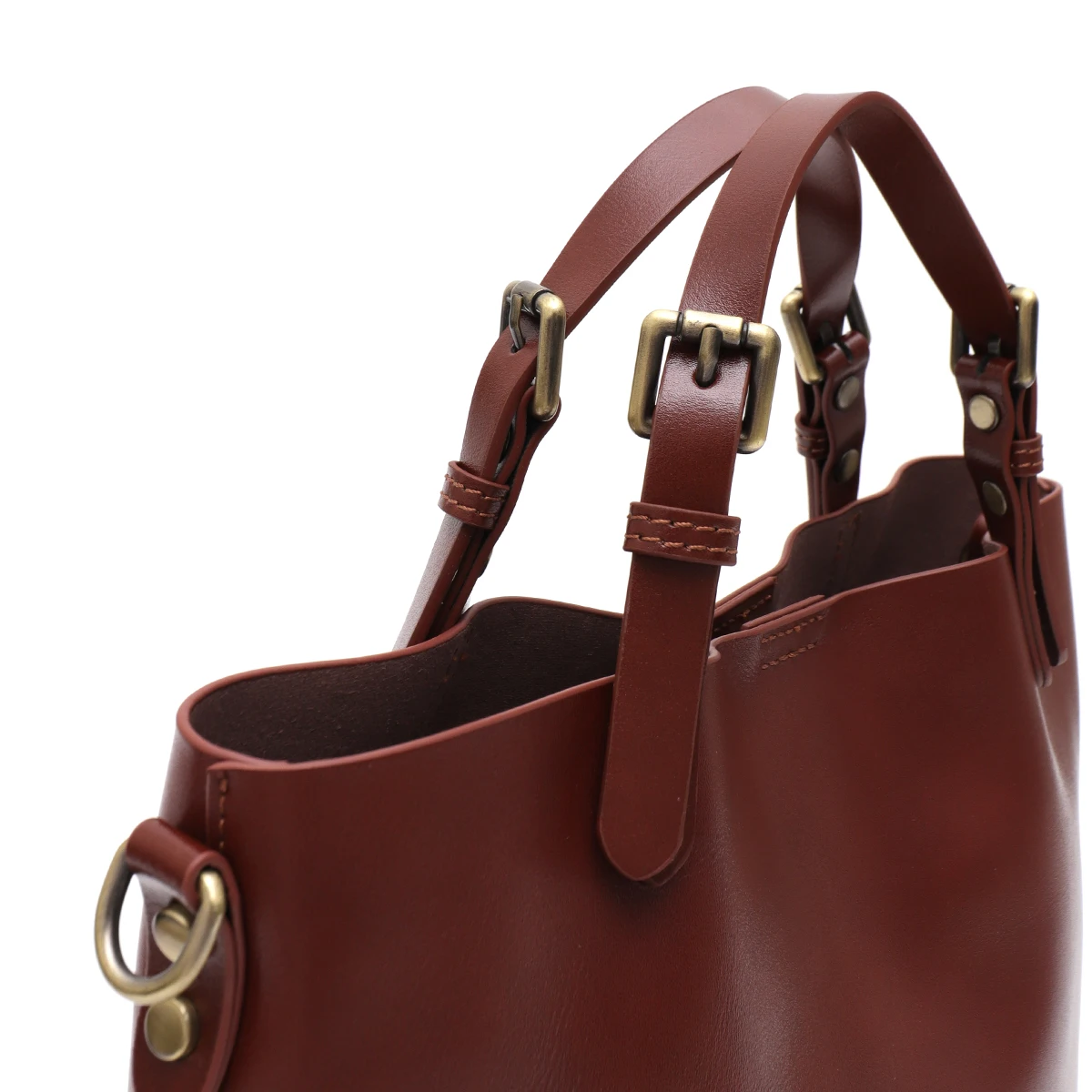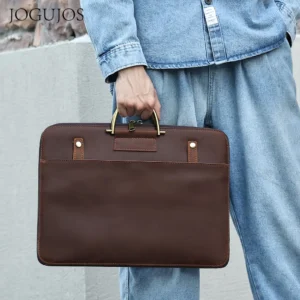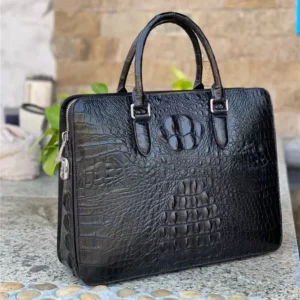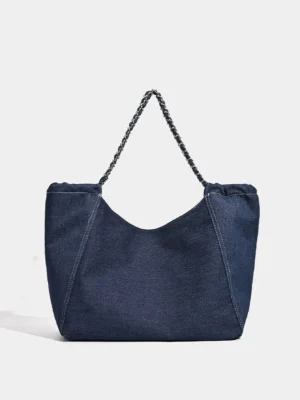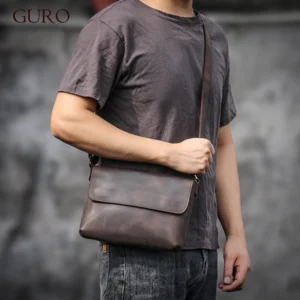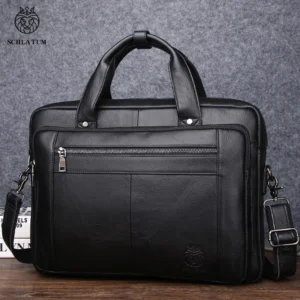Understanding Leather Basics
Leather stands as one of humanity’s oldest and most treasured materials, renowned for its durability, flexibility, and timeless appeal. When investing in premium leather goods, understanding the different leather types becomes crucial to making informed decisions that align with your needs and expectations.
In the hierarchy of leather quality, various grades exist, with full grain and top grain occupying the highest positions. Full grain represents the pinnacle of leather quality, while top grain follows as the second-highest grade. These distinctions aren’t just marketing terms—they reflect fundamental differences in processing, appearance, durability, and performance.
Throughout this article, we’ll explore these two premium leather types in depth, examining their unique characteristics, advantages, and ideal applications. This knowledge will empower you to make more informed decisions when selecting timeless classic leather briefcases for professional settings.
At Poise Porter, we prioritize leather quality in our professional accessories, understanding that defining best leather briefcases requires a deep appreciation of material properties and craftsmanship standards.
What is Full Grain Leather?
Full grain leather represents the highest quality leather available, derived from the topmost layer of the hide. What makes it special is that it remains virtually unaltered from its natural state, with the entire grain layer left intact during processing.
The manufacturing process for full grain leather is remarkably minimal. After removing hair and flesh, the hide undergoes tanning and finishing while preserving its natural surface. Unlike other leather grades, full grain leather isn’t sanded, buffed, or corrected to remove imperfections.
Distinguishing Characteristics of Full Grain Leather:
- Natural Appearance: Contains visible natural markings, growth lines, and character elements that make each piece unique
- Superior Durability: The intact, dense fiber structure creates exceptional strength and longevity
- Breathability: Maintains its natural pores, allowing air circulation and moisture regulation
- Patina Development: Develops a rich, personal patina over time that enhances its beauty and character
- Distinctive Texture: Offers a more robust, natural feel with variations across the surface
What truly sets full grain leather apart is how it tells a story. Each mark, scar, or variation represents the animal’s life experience, creating leather with character and authenticity. The intact fiber structure remains dense and strong, explaining why genuine full grain leather products can last decades or even generations when properly cared for.
For professionals seeking quality and longevity, our full-grain messenger bags showcase the natural beauty and durability of this premium leather grade. Many customers discover the numerous benefits of full-grain leather bags extend beyond mere aesthetics to practical advantages in professional settings.
What is Top Grain Leather?
Top grain leather occupies the second-highest position in leather quality hierarchy. It starts similarly to full grain, coming from the top portion of the hide, but undergoes additional processing that fundamentally changes its character and properties.
The manufacturing process is where top grain leather diverges significantly from full grain. After initial tanning, the leather’s surface is sanded and buffed to remove natural imperfections, markings, and some of the outermost grain layer. This process creates a more uniform appearance but removes some of the natural strength. Typically, a finishing coat is then applied to create a consistent color and add protective properties.
Distinguishing Characteristics of Top Grain Leather:
- Uniform Appearance: Features a smoother, more consistent surface free from natural markings
- Good Durability: While not as strong as full grain, remains durable for everyday professional use
- Reduced Breathability: The finishing process seals some natural pores, decreasing breathability
- Limited Patina: Develops less natural patina due to the altered surface and applied finishes
- Initial Softness: Often feels more supple and pliable initially compared to full grain options
Manufacturers choose to process leather this way primarily for aesthetic consistency and to create a more uniform product. The sanding removes natural imperfections that some consumers might perceive as flaws, while the finishing protects the leather and creates a more controlled appearance.
The top grain leather briefcase durability remains impressive for most professional needs, making it a practical option for daily use in various business environments. Many professionals appreciate its balance of quality and refined appearance for everyday business contexts.
Side-by-Side Comparison of Full Grain vs. Top Grain Leather
When choosing between these premium leather options, understanding their key differences becomes essential. The following comparison highlights the most important distinctions across critical factors:
| Characteristic | Full Grain Leather | Top Grain Leather |
|---|---|---|
| Source/Origin | Outermost layer of hide with natural surface intact | Outermost layer with top surface sanded/buffed |
| Visual Appearance | Natural variations, markings, and character elements visible | Uniform, consistent surface with imperfections removed |
| Durability | Superior strength; can last decades or generations | Good strength; typically lasts 5-10 years with proper care |
| Patina Development | Develops rich, distinctive patina that enhances with age | Limited patina development due to surface processing |
| Breathability | Highly breathable; natural pores remain open | Reduced breathability due to surface treatment and finishing |
| Feel and Texture | Robust, natural feel with textural variations | Smoother, more consistent feel across the surface |
| Cost | Higher price point reflecting quality and limited supply | Moderately priced; 20-40% less expensive than full grain |
| Stain Resistance | Natural resistance develops over time; initially more vulnerable | Better initial stain resistance due to protective finishing |
| Manufacturing Workability | More challenging to work with due to natural variations | Easier to manipulate and create consistent products |
The key insight from this comparison lies in understanding the trade-offs. Full grain leather offers superior durability and character development at the cost of showing natural imperfections and requiring more break-in time. Top grain provides greater consistency and immediate refinement but sacrifices some durability and unique character development.
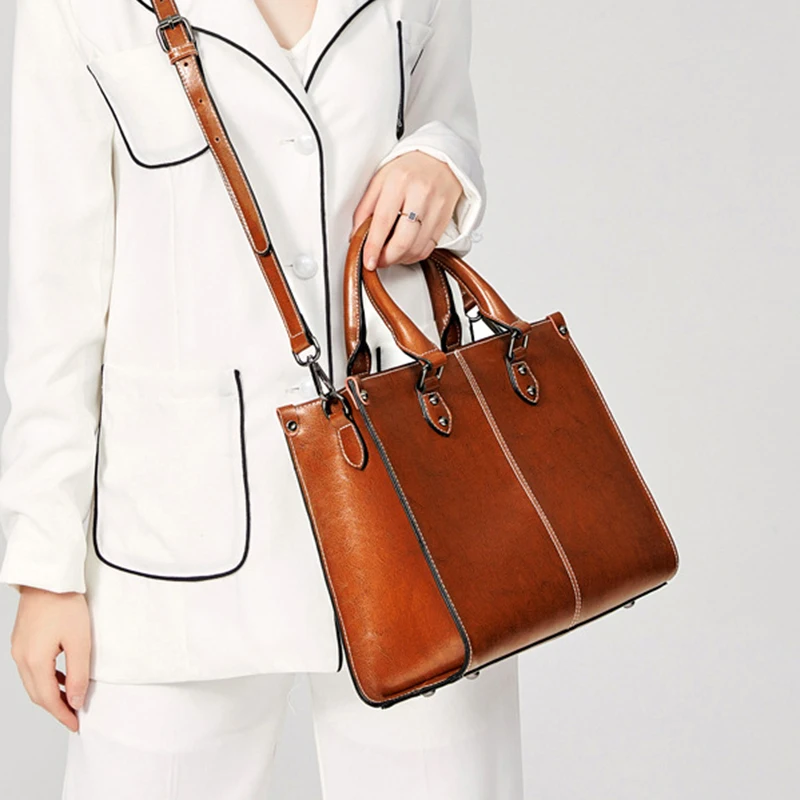
For a deeper exploration of these differences, our detailed guide on leather quality full grain vs top grain provides additional insights for discerning professionals.
Durability Analysis: Which Leather Type Lasts Longer?
When investing in professional leather goods, durability becomes a primary consideration. Full grain leather typically outlasts top grain due to several structural advantages:
Intact Fiber Structure: Full grain leather preserves the densely interconnected natural fibers, creating superior tensile strength and resistance to tearing.
Natural Oils Preservation: The unaltered surface retains more of the hide’s natural oils, maintaining flexibility and preventing premature cracking.
Superior Moisture Handling: The natural pore structure manages moisture more effectively, preventing the deterioration that often comes from repeated wetting and drying.
Thickness Advantage: Full grain products generally use thicker cuts of leather, providing additional structural integrity and wear resistance.
Top grain leather, while still durable, sacrifices some longevity through its processing. The sanding removes the densest fiber layers, potentially reducing the leather’s natural strength by 25-30%. Additionally, applied finishes can crack over time as the leather flexes and moves.
In practical terms, properly maintained full grain leather products often last 20+ years, while comparable top grain items typically provide 5-10 years of professional service before showing significant wear. This difference becomes particularly apparent in durable leather briefcase options that endure daily handling and stress.
Appearance and Aesthetic Evolution Over Time
Perhaps the most fascinating distinction between these leather types lies in how they transform with use and age. Full grain and top grain leather follow dramatically different aesthetic journeys over their lifespans.
Full grain leather undergoes a remarkable transformation called patina development. This natural process involves the leather absorbing oils from handling, developing a richer color, smoother texture, and distinctive character unique to its use pattern. Rather than deteriorating, full grain leather often becomes more beautiful with age, developing a warm luster and personal character that tells the story of its journey with you. This living quality makes each piece increasingly unique over time.
In contrast, top grain leather maintains a more consistent appearance throughout its life. The applied finish creates a protective barrier that resists the absorption that creates patina. While this means the leather looks more similar to its original state for longer, it misses the character development that many leather enthusiasts prize. When top grain leather does age, the changes tend to be more related to wear than beneficial patina.
Many professionals specifically select items like our crazy horse leather satchels precisely because they develop exceptional patina, making aging an enhancement rather than deterioration.
Price Factors: Why the Cost Difference?
The price difference between full grain and top grain leather reflects several important factors beyond simple quality distinctions:
Limited Supply: Only a small percentage of all hides meet the stringent requirements for full grain leather, creating natural supply limitations.
Selection Process: Identifying suitable hides requires skilled assessment and often means rejecting significant portions of available materials.
Manufacturing Complexity: Working with natural variations requires more skilled craftsmanship and adaptability during production.
Material Yield: Natural markings mean some portions of full grain hides may be unusable for visible areas, reducing overall material efficiency.
Thickness Requirements: Full grain leather often requires specific thickness parameters, further limiting usable supply.
Typically, full grain leather products cost 20-40% more than comparable top grain items. However, considering the substantial difference in longevity, full grain often represents better long-term value despite the higher initial investment.
For those balancing quality and budget considerations, exploring affordable quality leather briefcases can help identify options that meet professional needs without compromising essential quality standards.
Best Applications: Which Products Suit Each Leather Type?
Ideal Applications for Full Grain Leather:
- Investment-Grade Professional Items: Briefcases, portfolios, and messenger bags meant to last for many years
- Products Where Character Development Enhances Value: Items carried regularly where patina development is desirable
- High-Stress Items: Bags, straps, and handles that endure significant weight and tension
- Heritage Pieces: Products intended to be passed down or retained for many years
- Distinctive Professional Statements: When the natural character of leather communicates authenticity and quality
Ideal Applications for Top Grain Leather:
- Products Needing Consistent Appearance: Items where uniformity matters more than character
- Lighter-Colored Professional Accessories: When stain resistance is particularly important
- Fashion-Forward Items: Pieces where current style may outweigh long-term durability concerns
- Water-Resistant Requirements: When additional protection against moisture is necessary
- Budget-Conscious Professional Investments: Quality leather goods at more accessible price points
The choice ultimately depends on your priorities and the specific context of use. A daily-use professional briefcase might justify full grain’s durability, while a specialty portfolio seen less frequently might function perfectly in top grain leather.
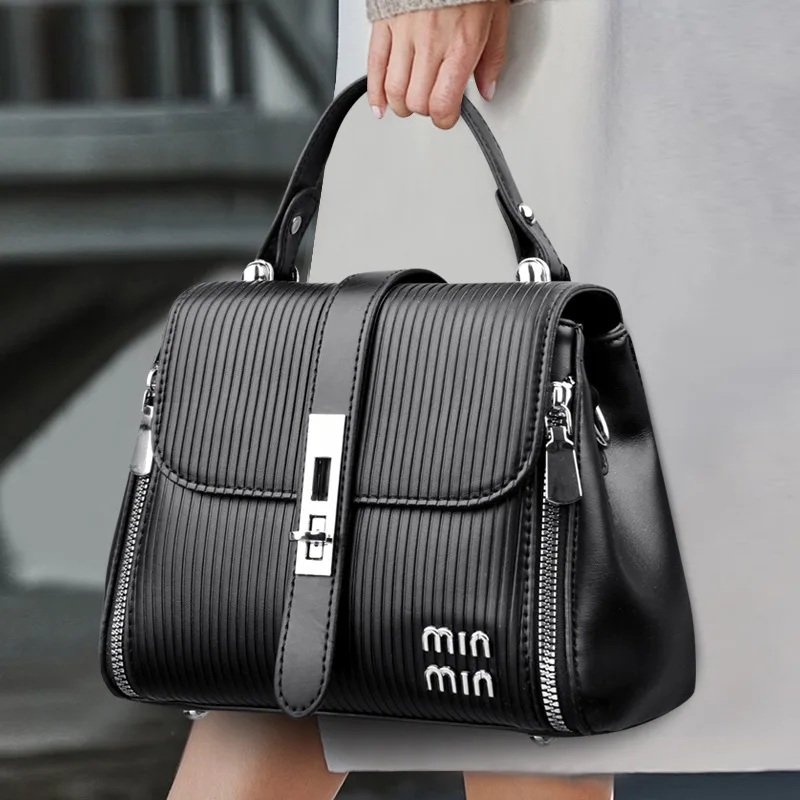
Our classic leather briefcases collection demonstrates how different leather types enhance various professional contexts and usage patterns.
How to Identify Quality: Authentication Tips
When shopping for leather goods, accurately identifying leather quality helps ensure you get what you pay for. Here’s how to distinguish between full grain and top grain leather:
Identifying Full Grain Leather:
- Visual Inspection: Look for natural variations, visible pores, and subtle imperfections that indicate an unaltered surface
- Edge Examination: Cut edges often reveal the dense fiber structure throughout the material
- Smell Test: Authentic full grain leather has a rich, natural aroma rather than chemical smells
- Touch Assessment: Should feel naturally textured rather than perfectly smooth
- Flexibility: Typically stiffer initially but flexes naturally, softening with use
Identifying Top Grain Leather:
- Surface Consistency: Unusually uniform appearance without natural variations
- Edge Analysis: May show a distinct layer where the surface differs from the body
- Finish Appearance: Often has a slightly slicker surface from protective finishing
- Water Drop Test: Water drops tend to sit on the surface longer before absorption
- Tactile Evaluation: Feels smoother and more consistent across the entire surface
Warning signs of misrepresentation include perfect uniformity in supposed full grain leather, unnaturally shiny surfaces, plastic-like feel, or edges that reveal layered construction. Understanding these indicators helps when choosing the perfect leather briefcase that meets your quality expectations.
Maintenance Requirements: Caring for Each Leather Type
Proper maintenance significantly impacts the lifespan and appearance of leather goods, with different requirements for each leather type.
Full Grain Leather Care:
- Regular Cleaning: Wipe with slightly damp cloth to remove dust and surface dirt
- Conditioning Schedule: Apply quality leather conditioner every 3-6 months to maintain natural oils
- Spot Treatment: Address spills immediately by blotting (never wiping) to prevent absorption
- Storage Considerations: Store in breathable cloth bags rather than plastic to prevent mold
- Weather Protection: Apply specialized leather waterproofing products before exposure to harsh conditions
Top Grain Leather Care:
- Surface Cleaning: Use leather-specific cleaners that won’t damage the protective finish
- Lighter Conditioning: Require less frequent conditioning (every 6-12 months) due to reduced absorption
- Finish Maintenance: May benefit from leather polishes that maintain the surface finish
- Scratch Management: Minor scratches can often be buffed out with a soft cloth
- Protective Measures: More vulnerable to cracking from dryness, so avoid prolonged heat exposure
The fundamental difference is that full grain leather requires more frequent care but responds better to conditioning, while top grain requires less maintenance but offers fewer restoration possibilities once damaged.
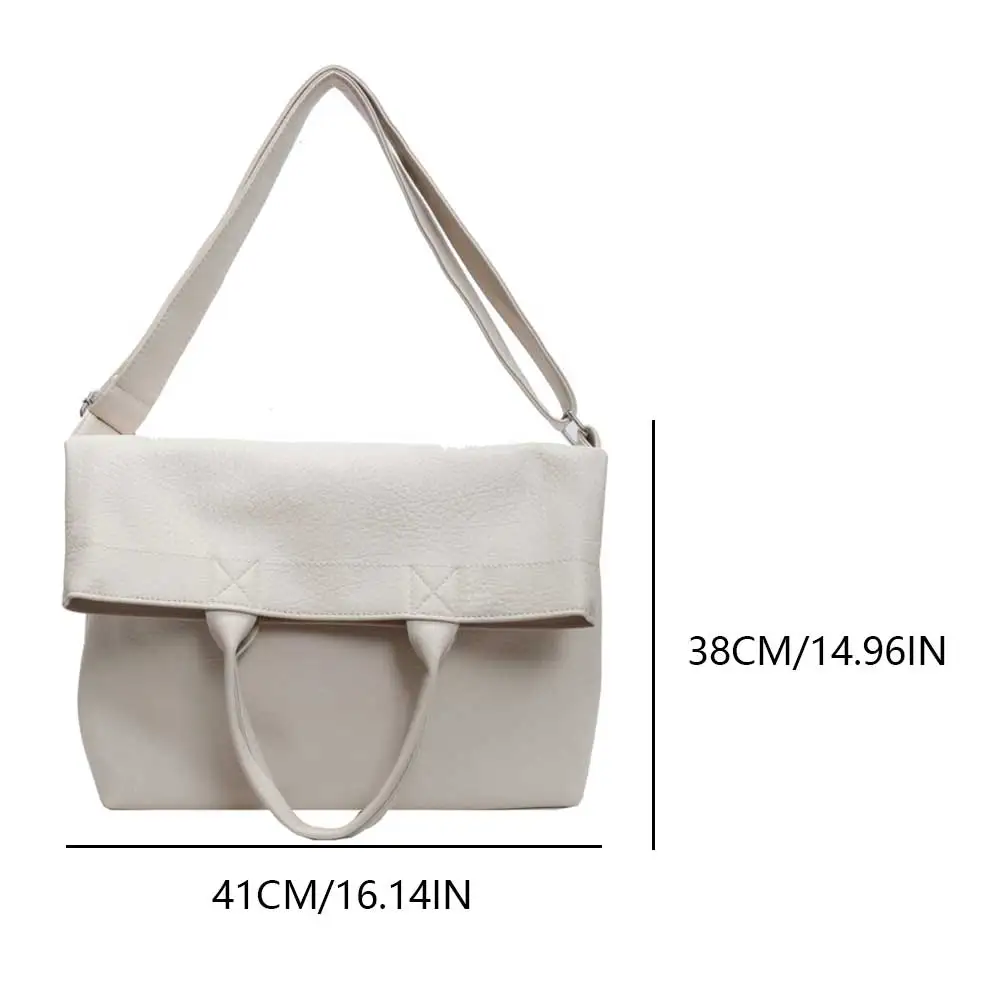
For comprehensive guidance on extending the life of your investment, our guide on how to maintain leather briefcases provides detailed care instructions tailored to different leather types.
Making the Right Choice: Decision Framework
Selecting between full grain and top grain leather becomes easier with a systematic approach based on your specific priorities and circumstances:
Choose Full Grain Leather When:
- Long-term durability is your primary concern
- You appreciate natural character and uniqueness
- You’re making a significant investment piece
- The developing patina enhances your professional image
- You don’t mind some initial break-in time
Choose Top Grain Leather When:
- Consistent appearance matters more than unique character
- You prefer immediate softness without break-in
- Budget considerations make full grain prohibitive
- You need greater initial stain resistance
- Replacement within 5-10 years aligns with your plans
Consider your daily environment as well. Full grain leather develops character faster with regular use, making it ideal for signature pieces you carry daily. Top grain might be preferable for specialty items used occasionally or in environments where maintaining a consistent, polished appearance takes precedence.
For visual examples of these principles in action, explore our leather messenger bags collection, which features both leather types applied to similar designs.
Men's Classic Leather Briefcase, Slim Leather Laptop Briefcase, Slim Leather Portfolio Briefcase
$93.67 Select options This product has multiple variants. The options may be chosen on the product pageClassic Laptop Briefcase, Men's Classic Leather Briefcase, Slim Leather Attache Case
Price range: $353.50 through $360.81 Select options This product has multiple variants. The options may be chosen on the product pageBlack Leather Briefcase, Leather Document Bag, Men's Classic Leather Briefcase
Genuine Crocodile Leather Executive Briefcase with Password Lock – Premium Business Document Carrier$1,201.87 Select options This product has multiple variants. The options may be chosen on the product pageCanvas & Leather Messenger Bag, Leather Commuter Tote
$80.41 Select options This product has multiple variants. The options may be chosen on the product pageCrazy Horse Leather Satchel, Men's Leather Satchel, Men's Professional Leather Messenger, Vintage Style Messenger Bag
$132.70 Select options This product has multiple variants. The options may be chosen on the product pageBlack Leather Briefcase, Classic Laptop Briefcase, Men's Classic Leather Briefcase, Slim Leather Laptop Briefcase
$228.72 Select options This product has multiple variants. The options may be chosen on the product page
Common Leather Terminology Misconceptions
“Is ‘genuine leather’ a mark of quality?”
Contrary to what many assume, “genuine leather” is not an indicator of high quality but rather a technical term identifying real leather (versus synthetic alternatives). It typically refers to leather from the lower layers of the hide after top and full grain portions have been removed, making it less durable than either top or full grain leather.
“Does all leather develop a patina?”
No. While full grain leather develops a rich patina over time, heavily processed leathers like top grain (to varying degrees), genuine leather, and especially corrected or painted leathers develop minimal patina due to their surface treatments blocking natural oil absorption.
“Is leather grading standardized globally?”
Unfortunately not. Leather terminology lacks universal standardization, allowing for marketing interpretation. This makes understanding the actual processing methods more important than relying solely on grade names.
“Are natural markings defects?”
In fine leather, natural markings indicate authenticity rather than defects. These characteristics—including subtle scars, wrinkles, and grain variations—confirm the leather’s natural origin and are prized in high-quality full grain products.
Understanding these distinctions helps avoid confusion when browsing products like our classic laptop briefcases, where quality variations significantly impact performance and longevity.
Top Questions About Full Grain and Top Grain Leather
Can top grain leather ever be better than full grain?
In specific applications—particularly where consistent appearance, stain resistance, and initial softness are paramount—top grain can be the more appropriate choice. However, for pure durability and aging characteristics, full grain remains superior.
Will my leather bag look significantly different after a year?
Full grain leather will develop noticeable patina within the first year, particularly in areas with frequent handling. Top grain leather will maintain a more consistent appearance but may show wear in high-friction areas without developing the same rich character.
Is full grain leather always the best choice for professional settings?
Not necessarily. While full grain offers premium quality, top grain’s consistent appearance sometimes projects a more uniform professional image in certain corporate environments. Consider your specific workplace culture and expectations.
How much more should I expect to pay for full grain vs. top grain?
Typically, full grain leather products cost 20-40% more than comparable top grain items. This price difference reflects both material quality and the additional craftsmanship often associated with full grain goods.
Do both types require special maintenance?
Yes, though with different emphases. Full grain leather requires more regular conditioning to maintain its natural properties but responds better to care. Top grain needs less frequent maintenance but benefits from products designed for finished leathers.
Which leather type is more environmentally sustainable?
Full grain leather typically represents better sustainability as it uses the hide more completely with fewer chemical processes. However, overall sustainability depends on tanning methods and manufacturing practices rather than grain type alone.
For additional guidance on selecting the right leather for your professional needs, our definitive guide to ideal leather briefcases addresses these considerations in greater detail.
Professional Image: Leather Choice and Perception
The leather you carry makes a subtle but significant statement about your professional identity. Full grain leather, with its natural variations and developing character, often communicates authenticity, attention to detail, and long-term thinking. As it ages and develops patina, it can reflect personal history and experience—valuable qualities in many professional contexts.
Top grain leather, with its more uniform appearance, can project polished consistency and meticulous presentation. Its refined surface often appears more formal initially, making it suitable for highly structured corporate environments where traditional appearances matter.
Your industry and specific role influence which of these impressions serves you best. Creative professionals often embrace the character of full grain leather as complementary to innovative thinking, while those in more traditional sectors might prefer the consistent refinement of top grain.
Both options, when well-crafted, significantly outperform lower-grade alternatives in projecting competence and attention to quality. For examples of how leather choice impacts professional appearance, our men’s classic leather briefcase collection demonstrates these principles across various professional styles.

